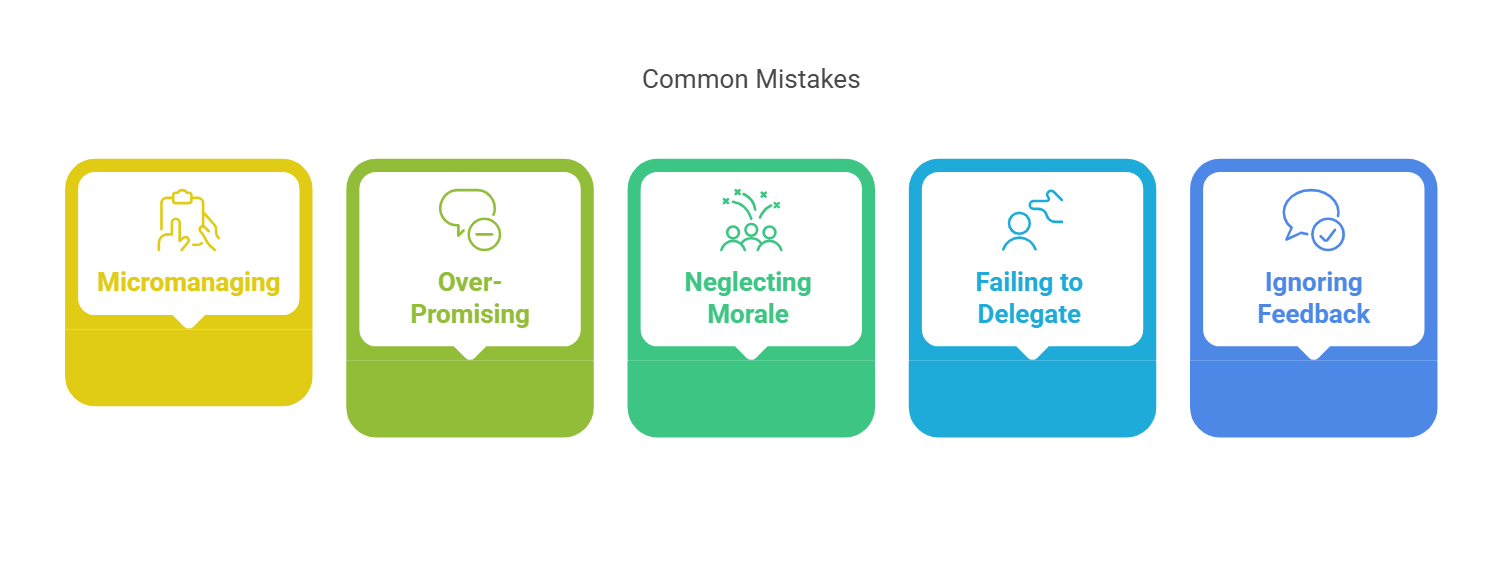When I was a junior engineer, I remember watching my team leader handle a particularly stressful situation. A major deadline was approaching, and the entire team was struggling to fix a bug that had the potential to derail the project. Instead of panicking, he gathered us in a meeting room, broke the problem into smaller pieces, and assigned clear tasks to everyone. By the end of the day, the bug was resolved, and the project stayed on track.
What struck me most wasn’t his technical knowledge, though it was impressive—it was his ability to stay calm, inspire the team, and make us feel like we could handle anything. That day, I realized leadership wasn’t just about solving problems yourself but about enabling others to succeed.
If you’ve ever wondered what it takes to lead an engineering team effectively, you’re not alone. Leadership can seem like a big leap, but it’s really a series of small steps, starting with the skills and habits you cultivate today.
In this guide, we’ll break down practical strategies to help you transition from being a contributor to an engineering leader who drives results, builds trust, and empowers their team.
Why Leadership Matters in Engineering
That day with my team leader taught me an invaluable lesson: strong leadership isn’t about knowing all the answers—it’s about guiding others to find them. In engineering, where projects are often high-stakes and fast-paced, leadership acts as the glue that holds everything together. It turns scattered efforts into focused progress, ensuring teams remain aligned and productive, even under pressure.
Effective leadership goes beyond managing deadlines. It’s about:
- Balancing technical responsibilities with guiding the team.
- Managing limited resources without compromising quality.
- Maintaining morale and focus, even when priorities shift unexpectedly.
Great engineering leaders do more than oversee tasks—they build environments where their teams thrive. They align technical efforts with larger business goals, foster collaboration, and provide clarity in moments of uncertainty. Most importantly, they inspire confidence, helping individuals rise to challenges and deliver their best work.
Without strong leadership, even the most skilled team can lose direction. But with it, the potential for innovation and productivity becomes limitless.
How to Become an Engineering Team Leader- Step-by-Step Guide

Step 1: Build a Strong Technical Foundation
Our technical skills are key to earning your team’s respect and trust. A leader who understands the challenges engineers face gains credibility and makes smarter decisions. When your team seeks guidance, your technical expertise ensures you can provide clear, informed direction, strengthening both their confidence in you and the quality of your leadership.
Here’s how to strengthen your technical foundation:
- Stay Updated: Read industry blogs, follow new tech trends, and attend conferences to stay informed.
- Get Your Hands Dirty: Participate in design reviews or tackle tricky bugs alongside your team. It shows you’re still connected to the work.
- Learn Continuously: Take online courses, explore new tools, or learn programming languages relevant to your projects.
Being technically strong doesn’t mean doing everything yourself. It’s about having the knowledge to support your team and make decisions with confidence.
Step 2: Develop Empathy and Communication Skills
Good leadership isn’t just about solving problems—it’s about connecting with people. Teams perform best when they feel heard and understood. Empathy and clear communication create trust, fostering better collaboration and stronger performance.
Practical Ways to Build Empathy:
- 1-on-1 Conversations: Meet with your team members individually to learn their goals and concerns. Listen more than you talk.
- Join Discussions: Sit in on brainstorming sessions to understand how your team thinks and collaborates.
- Active Listening: Pay full attention during conversations. Instead of planning your response, focus on what’s being said.
Tips for Effective Communication:
- Bridge the Gap: Explain technical concepts in simple terms so stakeholders and non-engineers can follow.
- Encourage Openness: Create a space where people feel safe to share ideas or raise concerns.
- Be Clear and Direct: Whether you’re sharing a decision or explaining a process, clarity prevents misunderstandings.
Empathy helps you connect with your team, while strong communication keeps everyone aligned and motivated.
Step 3: Learn to Prioritize and Say No
As a leader, competing demands from stakeholders, team members, and deadlines are inevitable. Prioritizing effectively—and saying no when needed—helps protect your team from burnout and keeps projects on track.
Why Saying No Matters: Saying no isn’t rejection; your team has limited time and resources. Overcommitting leads to missed deadlines and poor-quality work. Saying no isn’t about refusing outright—it’s about setting realistic expectations and ensuring quality work by focusing on what matters most.
Practical Frameworks for Prioritization:
- MoSCoW Method: Classify tasks into Must-Have, Should-Have, Could-Have, and Won’t-Have categories to focus on what truly matters.
- Agile Sprints: Break projects into smaller, manageable tasks and regularly reassess priorities.
Example: A stakeholder asks for a new feature that conflicts with your timeline. Instead of a flat-out no, explain: “If we add this feature, we’ll need to delay X. Would you like us to adjust priorities?” This keeps communication open and avoids overloading your team.
Step 4: Encourage Accountability and Ownership
A team that takes ownership of its work stays engaged, motivated, and focused on delivering quality results. Accountability fosters pride and responsibility, leading to stronger outcomes for both the team and the organization.
How to Promote Accountability:
- Use Project Tools: Tools like Jira or Trello provide visibility into progress, so everyone knows what’s expected.
- Encourage Peer Reviews: Reviewing each other’s work boosts collaboration and ensures higher quality.
- Recognize Efforts: Celebrate milestones and call out good work. Positive reinforcement builds confidence and morale.
Remember, accountability starts with you. By taking responsibility for your own actions and decisions, you set the tone for your team.
Step 5: Master Stakeholder Management
As a leader, your responsibilities extend beyond your team. Stakeholders bring their own goals and priorities, which may not always align with yours. Building trust through open communication ensures everyone stays aligned and focused on achieving shared objectives.
Key Strategies:
- Active Listening: Understand what stakeholders need and why. This helps you align their goals with your team’s capabilities.
- Be Transparent: Share regular updates on progress, challenges, and timelines. It prevents surprises and builds confidence in your leadership.
- Set Realistic Expectations: Be honest about what’s possible within your team’s capacity. Over-promising might please people in the short term, but it creates long-term issues.
Strong stakeholder management ensures your team’s work aligns with larger business objectives.
Step 6: Lead by Example and Keep Growing
Leadership is about action, not authority. Your team looks to you for guidance, so model the behaviors and standards you expect. Continuously improving yourself inspires them to do the same.
How to Lead by Example:
- Be consistent in your work ethic and approachability.
- Admit mistakes and take corrective action openly. It shows accountability.
- Stay calm during challenges and focus on finding solutions.
Keep Learning: Leadership isn’t static—it evolves as your team and projects grow. Seek feedback from your peers and team members. Attend workshops or read books on leadership and team dynamics. Staying curious and adaptable keeps you ahead of the curve.
Ready to take the first step? Start by applying one of these strategies today, and watch how it transforms your approach to leadership.
Addressing Industry-Specific Challenges & How to Overcome
Engineering leadership varies widely depending on the field. A software engineering leader may prioritize speed and adaptability, while a hardware engineering leader focuses on planning and precision. Recognizing these nuances allows you to align your leadership style with the needs of your industry.

1. Software Engineering
Challenges:
- Rapid Pace: Constantly changing technologies and tight deadlines demand quick decision-making.
- Distributed Teams: Managing remote or cross-time-zone teams can create communication gaps.
How to Succeed:
- Embrace Agile Principles: Agile frameworks like Scrum or Kanban help teams respond to changes without losing momentum.
- Foster Real-Time Collaboration: Tools like Jira and Slack keep communication flowing, while shared dashboards provide visibility into progress.
- Focus on Team Connection: Schedule regular check-ins and virtual bonding activities to bridge gaps in remote teams.
2. Hardware Engineering
Challenges:
- Long Development Cycles: Extensive prototyping and testing lead to drawn-out timelines.
- Resource Constraints: Dependence on external suppliers and manufacturing delays can disrupt progress.
How to Succeed:
- Plan for Risks: Create contingency plans for common resource issues or delays, ensuring your team can adjust quickly.
- Collaborate Early: Involve cross-functional teams, like procurement and quality assurance, from the start to anticipate bottlenecks.
- Track Milestones: Break large projects into milestones so progress is visible and manageable.
3. Manufacturing Engineering
Challenges:
- Efficiency and Scale: Large-scale production requires constant optimization.
- Regulatory Pressures: Meeting safety and compliance standards adds complexity to operations.
How to Succeed:
- Adopt Lean Principles: Use methodologies like Six Sigma to identify inefficiencies and eliminate waste in production.
- Train the Team on Compliance: Regular training sessions ensure everyone is up-to-date on safety and quality standards.
- Monitor in Real-Time: Invest in software that tracks production data to identify issues before they escalate.
4. Emerging Fields (e.g., AI, Robotics, Renewable Energy)
Challenges:
- Innovation Pressure: Industries like AI and robotics demand continuous breakthroughs.
- Diverse Expertise: Collaboration between specialists from different fields can create friction.
How to Succeed:
- Create a Sandbox for Innovation: Allocate resources for experimentation without affecting core projects.
- Encourage Knowledge Sharing: Hold regular sessions where team members teach each other about their respective domains.
- Use Unified Platforms: Tools like Notion or Miro make collaboration across diverse teams smoother and more intuitive.
Adapting your leadership to fit the unique demands of your industry isn’t just useful—it’s essential. Tailoring your approach helps you overcome obstacles while empowering your team to achieve exceptional results. Start by understanding the challenges of your field, and then refine your strategies to align with your team’s strengths and goals.
Highlighting Career Progression as an Engineering Team Leader
Becoming an engineering team leader is more than a title—it’s a critical step in bridging technical expertise with leadership. This role prepares you for higher responsibilities by requiring you to think strategically, support team growth, and align technical efforts with organizational goals.
Here’s how the team leader role fits into a broader career path:
- From Technical Expert to Strategic Thinker: Moving beyond solving problems yourself, you’ll learn to delegate and make decisions that benefit the team as a whole.
- From Focusing on Output to Outcomes: The focus shifts from delivering code or designs to driving team efficiency, innovation, and impact.
- From Self-Driven to Collaborative Leadership: You’ll transition from working individually to empowering others and managing cross-functional collaborations.
Understanding this evolution helps you navigate the transition and prepare for roles like Director of Engineering or CTO.
Why This Role is a Stepping Stone
Unlike individual contributor roles, leadership challenges you to:
- Prioritize Team Success Over Personal Recognition: Your impact is measured by the team’s accomplishments, not your contributions.
- Manage Up and Down: You’ll advocate for your team with stakeholders while supporting their growth and well-being.
- Think Beyond the Immediate: Strategic planning, resource allocation, and long-term goals become part of your responsibilities.
Common Mistakes to Avoid as a New Engineering Leader

Stepping into a leadership role brings its own set of challenges. Avoid these common pitfalls by focusing on practical solutions that build trust, inspire your team, and drive results.
- Micromanaging:
Trusting your team is essential. Hovering over every detail erodes trust and stifles creativity.
How to Avoid: Set clear expectations for deliverables, establish regular check-ins instead of constant monitoring, and let team members find their solutions. For instance, assign ownership of a feature and provide support only if asked. This encourages accountability and builds confidence.
- Over-Promising:
Saying yes to everything can lead to burnout, missed deadlines, and strained relationships with stakeholders.
How to Avoid: Use prioritization frameworks like MoSCoW or RICE to determine what’s feasible within your team’s capacity. Be honest about timelines and trade-offs—for example, “If we prioritize Feature A, Feature B will need to be delayed. Does that work?” This keeps expectations realistic.
- Neglecting Morale:
A disengaged or stressed team performs poorly and may lead to high turnover.
How to Avoid: Check in regularly through 1-on-1 meetings to understand how your team feels about their workload and work environment. Celebrate wins, even small ones, and encourage open dialogue about challenges. A simple acknowledgment like, “Great work on solving that bug under pressure!” can go a long way.
- Failing to Delegate:
Trying to do everything yourself slows progress and leads to exhaustion.
How to Avoid: Delegate tasks based on individual strengths and trust your team to deliver. For example, assign a senior engineer to lead code reviews or mentor junior developers. This not only lightens your load but also builds their skills.
- Ignoring Feedback:
Dismissing input from your team alienates them and limits innovation.
How to Avoid: Create a culture of feedback by asking for input in retrospectives or through anonymous surveys. Act on suggestions where possible—for instance, if a team member suggests a new tool to improve workflow, evaluate and implement it if feasible. Visible action on feedback strengthens trust.
Avoiding these mistakes lays the groundwork for a supportive and productive team culture. Leaders who prioritize trust, communication, and balance create environments where their teams feel empowered to innovate and succeed.
Conclusion
Leadership isn’t about having all the answers—it’s about creating an environment where your team feels empowered to find solutions and thrive. Transitioning into an engineering team leader role is a journey, one that challenges you to grow not just as a professional but as a mentor, strategist, and communicator.
From building a strong technical foundation to mastering communication and prioritization, leadership requires consistent effort and adaptability. The steps outlined in this guide—whether it’s delegating tasks, aligning with stakeholders, or avoiding common pitfalls—are not just strategies but habits that will shape your success.
Take time to reflect on where you are today and what skills you can start developing. Leadership is less about titles and more about impact. By enabling your team to achieve their best, you’ll naturally earn their trust and respect.
Leadership isn’t a destination—it’s a journey. Start by applying one or two of these strategies today, and watch how they transform both your approach and your team’s results.




